Scindapsus Pictus ‘Argyraeus’: Plant Care and Growing Guide (Pictures)
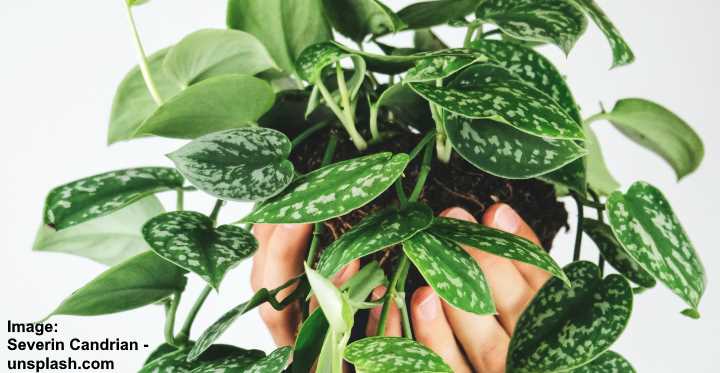
Scindapsus pictus ‘Argyraeus’ is a beautiful trailing plant with eye-catching heart-shaped velvety leaves and silver markings. Also called Satin Pothos and Philodendron Silver, this green and silver vining plant is an easy-to-grow houseplant. The variegated spotted leaves on the Scindapsus pictus ‘Argyraeus’ long vines look impressive growing in hanging baskets or climbing up a moss pole.
This article is a complete care guide on how to grow Scindapsus pictus ‘Argyraeus’ as an indoor plant. At the end of the article, you’ll find handy growing tips on resolving common issues with this pothos-like plant.
How to Care for Scindapsus pictus ‘Argyraeus’
To care for Scindapsus pictus ‘Argyraeus,’ grow the vining foliage plant in bright light, protected from direct sunlight. Plant the Scindapsus cultivar in fertile, well-drained potting soil and water when the top layer of soil dries. Grow in temperatures between 65-85°F (18-29°C) and above-average humidity. Fertilize monthly during the growing season.
What is Scindapsus pictus ‘Argyraeus’?
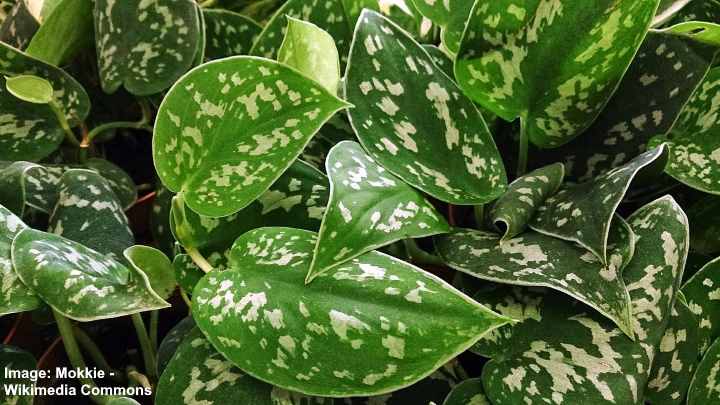
Scindapsus pictus ‘Argyraeus’ (satin pothos) is a vining houseplant with green leaves and silver markings
Scindapsus pictus ‘Argyraeus’ is species of evergreen flowering plant in the genus Scindapsus and family Araceae. Scindapsus pictus is native to tropical forests in Asia. In temperate regions, the evergreen climber thrives as a houseplant.
Scindapsus pictus ‘Argyraeus’ is a trailing plant with characteristic heart-shaped variegated leaves, small insignificant flowers, and long stems. In the wild, the vines reach up to 10 ft. (3 m) tall and climb up trees and other plants. Indoors, the trailing stems grow up to 3 ft. (1 m).
Scindapsus pictus ‘Argyraeus’ has the common names Philodendron Silver and Satin Pothos, Silver Pothos, and silver vine. However, the indoor vine isn’t a type of Pothos or Philodendron. Its botanical name pictus means “painted” and refers to the silvery variegation on the matte velvety leaves.
Scindapsus pictus ‘Argyraeus’ Leaves
Scindapsus pictus ‘Argyraeus’ leaves are cordate (heart-shaped) with a silky feel to them. The oval, pointed leaves are identified by their silvery markings that look like splashes of dull silver paint on matte green blades. The silver blotches are complemented with a silver lining running along the leaf’s margin.
Scindapsus pictus ‘Argyraeus’ Care Guide
Let’s look in more detail at how to care for a Scindapsus pictus ‘Argyraeus’ houseplant.
Scindapsus pictus ‘Argyraeus’ Light Requirements
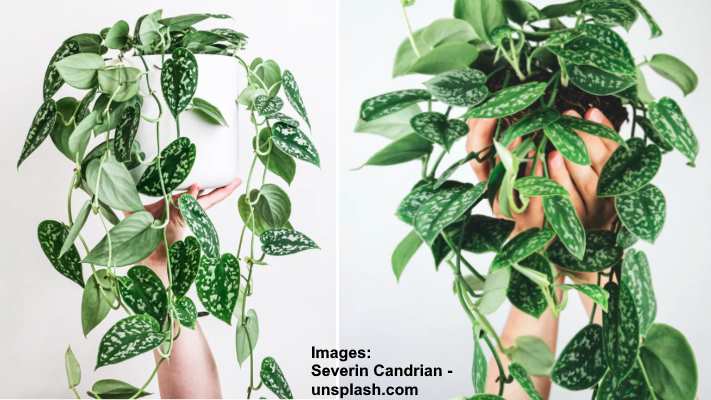
Grow the Scindapsus pictus ‘Argyraeus’ houseplant in indirect light
Scindapsus pictus ‘Argyraeus’ thrives in bright, indirect sunlight. Bright light is necessary to grow the hanging basket plant to keep the variegation vibrant. The best place to grow the plant is at an east- or west-facing window. If the Scindapsus pictus ‘Argyraeus’ is in direct sunlight, protect it behind a sheer curtain.
It’s good to note that Scindapsus pictus ‘Argyraeus’ grows in dappled sunlight on the forest floor in its native habitat. The sun’s intense rays can scorch the leaves, turning them an unsightly yellow color.
Although Scindapsus pictus ‘Argyraeus’ needs plenty of light, it’s tolerant of some shade. However, it is not a plant that thrives in low light. Too much shade causes the silvery splotches to fade, and the velvety leaves can turn completely green. If you notice that the silver leaf patterns begin to fade, move the pot to a brighter location.
The Best Soil for Potted Scindapsus pictus ‘Argyraeus’ Houseplant
Scindapsus pictus ‘Argyraeus’ grows best in a fertile potting mix that has excellent drainage. To create the ideal growing medium, combine three parts peat moss, one part perlite, and one part shredded bark. This DIY houseplant soil mix retains moisture without staying too soggy.
To grow Scindapsus pictus ‘Argyraeus’ indoors, you can also plant it in a commercial soil mix for succulents. You can amend the soil with some peat moss and perlite to make it drain better. Other soil amendments to boost drainage include charcoal pieces, pumice, and coco coir chips.
The ideal potting soil for Scindapsus pictus ‘Argyraeus’ should let water drain quickly. This is essential for the plant’s healthy growth as waterlogged soil causes roots to rot. However, the soil area around the roots should be constantly moist.
How to Water Scindapsus pictus ‘Argyraeus’ Plant
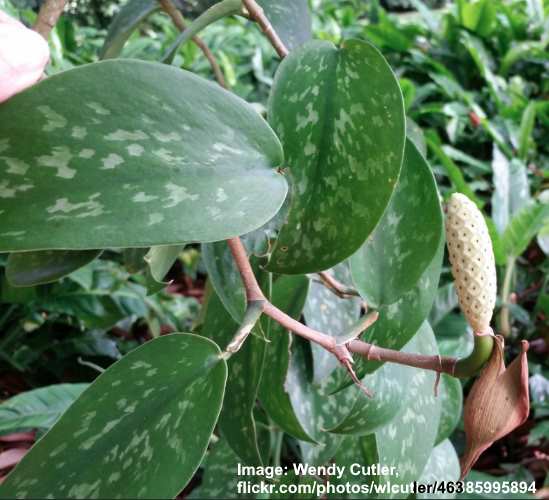
Avoid overwatering your Scindapsus pictus ‘Argyraeus’ plant to prevent root rot
Water Scindapsus pictus ‘Argyraeus’ as often as the top 2” (5 cm) of soil dries out. This may mean watering as often as once or twice a week in summer but less frequently in winter. Drenching the soil and letting it dry keeps the roots moist without becoming too soggy.
To know when it’s time to water Scindapsus pictus ‘Argyraeus,’ check the soil’s moisture. Poke your finger into the potting mix. If it’s dry, then it’s time to water the plant thoroughly. If there’s any moisture, hold off watering for a few days.
A common mistake when watering houseplants is to water them on a schedule. This often results in overwatering tropical plants, putting them at risk of root rot. Decaying roots is the primary reason plant foliage turns yellow, and the stems become mushy.
Here are a few handy tips to water Scindapsus pictus ‘Argyraeus’:
- Make sure the top 2” (5 cm) is dry before drenching the potting soil.
- Soil moisture evaporates faster in warm, dry weather; therefore, the plant requires more frequent watering.
- Avoid watering the plant too often, as the roots can quickly rot.
- Water the soil evenly around the pot to encourage healthy growth.
- Only water the plant occasionally in winter because the plant growth becomes dormant.
Scindapsus pictus ‘Argyraeus’ Growth Rate
Scindapsus pictus ‘Argyraeus’ is a slow-growing vining plant. As a houseplant, the Scindapsus pictus matures at about 3 ft. (1 m) long. However, it takes a few years for the plant to reach its full size. Usually, the satin pothos grows faster in summer when it’s warm and humid.
Scindapsus pictus ‘Argyraeus’ Temperature Guide
Scindapsus pictus ‘Argyraeus’ grows well in average room temperatures. For the plant to thrive, keep it in temperatures between 65 and 85°F (18-29°C). The plant’s minimum temperature is 60°F (16°C). Cold temperatures will damage the beautiful silvery-green velvety leaves.
Scindapsus pictus ‘Argyraeus’ doesn’t like sudden temperature changes. It’s best to keep the trailing vines out of cold drafts, such as from drafty windows or air-conditioning airflow. Additionally, protect the potted houseplant from heat vents and don’t place it too close to a radiator.
Scindapsus pictus ‘Argyraeus’ grows outdoors in USDA zones 11 and 12. You can take potted tropical plants outdoors in the summer, as long as the temperature doesn’t drop below 60°F (16°C).
Scindapsus pictus ‘Argyraeus’ Humidity Needs
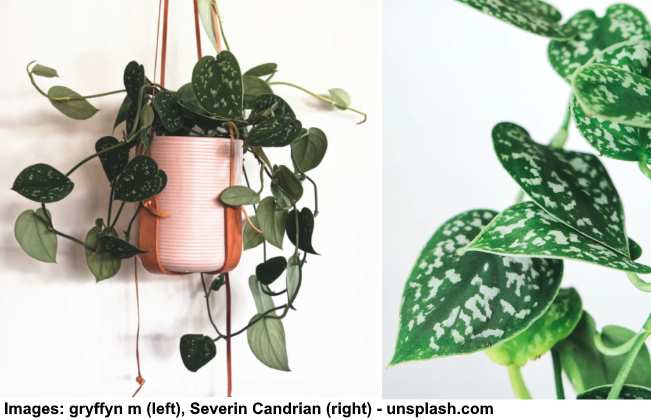
Aim for humidity levels of at least 40% for the fastest growth of Scindapsus pictus ‘Argyraeus’
Scindapsus pictus ‘Argyraeus’ grows best when relative humidity is around 40 or 50 percent. Even though the plant’s native habitat is the warm and humid tropics, Scindapsus pictus ‘Argyraeus’ adapts well to household humidity. If your home has particularly dry air—for example, when the heating is on in winter—you may have to increase humidity.
Keeping air humidity relatively high is vital for healthy growth. Dry air can result in brown tips developing on the pointed leaves.
Here are some simple tips on increasing humidity when growing Scindapsus pictus ‘Argyraeus’ indoors:
- Pebble tray—Put a layer of decorative pebbles in a tray and pour in water until it’s halfway up the stones. Place the potted Argyraeus on the pebbles. The evaporating water hydrates the plant’s foliage.
- Group houseplants—Grow your indoor plants together to create a humid micro-climate to encourage healthy growth.
- Room humidifier—Place a room humidifier near your hanging pothos plants to increase air moisture and prevent damage to foliage.
Misting the Scindapsus pictus ‘Argyraeus’ leaves can help increase humidity, but not for long. Misting the silky heart-shaped leaves and wiping them with a clean cloth can help to remove dirt and dust. However, misting tropical leaves won’t resolve a general lack of air humidity.
How to Fertilize Scindapsus pictus ‘Argyraeus’
Scindapsus pictus ‘Argyraeus’ benefits from fertilizing every four weeks during the growing season. Use a balanced houseplant fertilizer, diluted to half-strength. Fertilize the Scindapsus pictus monthly after regular watering to encourage healthy leaf growth. Hold off fertilizing during late fall and winter when the plant doesn’t grow.
It’s crucial to remember that mineral salts can build up in houseplant potting soil. This can result in foliage burn and brown leaves. To prevent this from happening, it’s a good idea to flush the potting mix every three months. All you need to do is run water through the soil for a few minutes to rinse excess fertilizer.
Top tip for healthy Scindapsus pictus ‘Argyraeus’ growth: Don’t over-fertilize tropical vining plants as it can kill the plant.
How to Prune Scindapsus pictus ‘Argyraeus’ Vining Plants
Scindapsus pictus ‘Argyraeus’ doesn’t require much pruning. The slow-growing trailing plant takes few years to reach its mature height of 3 ft. (1 m). But pruning is necessary to remove leggy stems that have sparse foliage. You can trim back long leafy vines to control the plant’s height or length.
Some plant owners prune potted Scindapsus pictus ‘Argyraeus’ to encourage bushier growth. To prune the plant, cut stems to the required length just before a node. New leaf growth will emerge from the node.
Other reasons for pruning Scindapsus pictus ‘Argyraeus’ include removing yellow leaves, dead foliage, or taking stem cuttings for propagation.
Scindapsus pictus ‘Argyraeus’ Propagation
Scindapsus pictus ‘Argyraeus’ propagation is by stem cuttings. Like many trailing houseplants, Scindapsus pictus ‘Argyraeus’ is easy to propagate. All you need to do is take a 5” to 6” (12 – 15 cm) length of stem with three nodes. Cut the stem just below the node and remove the lower leaves.
To grow a new Scindapsus pictus ‘Argyraeus,’ put the stem cutting in a jar of water to root. After a few weeks, 1” (2.5 cm) white roots should have appeared. Transfer the cutting to a pot filled with fresh potting soil, water thoroughly, and put in a bright location to grow.
How to Repot Scindapsus pictus ‘Argyraeus’
Scindapsus pictus ‘Argyraeus’ requires repotting every year or two. Although it’s not a fast-grower, transferring to a new, larger container encourages fuller growth. But it’s only necessary to repot the hanging basket plant when it becomes rootbound. Signs it’s time to repot the plant are stunted growth, roots poking out the pot or poor water drainage.
To repot a Scindapsus pictus ‘Argyraeus,’ remove the root ball from its container. Shake the roots free from dirt and check for dead or decaying roots—trim as necessary. Choose a pot one size larger than its current one. Fill with fresh, loose potting soil, and grow as usual.
It’s not a good idea to choose a pot that’s too big. Overly large containers tend to hold too much moisture. This can lead to root decay and eventually kill your evergreen climber.
Is Scindapsus pictus ‘Argyraeus’ Toxic?
Scindapsus pictus ‘Argyraeus’ is poisonous to cats, dogs, and other animals. The ASPCA says that Scindapsus pictus ‘Argyraeus’ contains insoluble calcium oxalates. This toxic substance can cause oral irritation and swelling, excessive drooling, and difficulty swallowing.
Doctors also say that plants containing calcium oxalates can affect humans as well. The sap can cause dermatitis, itching, burning, and pain if it comes into contact with the mouth or skin.
Pests Affecting Scindapsus pictus ‘Argyraeus’ Growth
Scindapsus pictus ‘Argyraeus’ is rarely bothered by common household plant pests. Usually, the two pests affecting satin pothos plants are spider mites and scale insects. To get rid of houseplant bugs fast, use a homemade neem oil solution. Combine 2 tsp. neem oil, 1 tsp. dish soap and a quart (1 l) of water in a spray bottle. Spray foliage once a week to eradicate houseplant pests.
To ensure your tropical plants such as Scindapsus pictus ‘Argyraeus’ stay pest-free, inspect them regularly for signs of infestations.
Here are a few tips on spotting pests on Scindapsus pictus ‘Argyraeus’ houseplants:
- Spider mites—Look for web-like strands hanging from leaves and stems. A severe spider mite infestation looks like webbing under leaves and at stem joints. You may also see tiny white or red spider-like creatures under foliage.
- Scale insects—Scale looks like tiny bumps or growths on plant stems. Even though the insects don’t seem to move, they are destroying your plant’s foliage by sucking on its juices. You can remove scale by dabbing some rubbing alcohol on the bumpy growths.
Related reading: The complete guide to using neem oil on houseplants.
Diseases Affecting Scindapsus pictus ‘Argyraeus’ Growth
Root rot is the most common disease affecting Scindapsus pictus ‘Argyraeus’ growth. Roots start to rot when they sit in soggy soil for too long. The excess moisture causes decay, and fungal infections can affect the plant. You can spot signs of root rot by foliage and stems that turn black and mushy.
To avoid root rot, always water Scindapsus pictus ‘Argyraeus’ properly. The best way to water most houseplants—including Scindapsus pictus—is to allow the soil to dry partially between watering.
If you notice signs of plant disease, it’s vital to stop watering until the soil dries. However, you may need to replace the soil with a fresh potting mix. If root decay is extensive, it’s probably best to take healthy stem cuttings to propagate a new plant and discard the diseased plant.
Caring for Scindapsus pictus ‘Argyraeus’ (Satin Pothos) — FAQs
Scindapsus pictus ‘Argyraeus’ is an easy-care, low-maintenance hanging basket or climbing plant. If you care for the plant well, you’ll have few—if any—problems growing it at home. However, some issues can affect its growth.
Why is my Scindapsus pictus leaves curling?
Scindapsus pictus ‘Argyraeus’ can start curing due to over or underwatering, too much heat, or too little sunlight. Issues with watering prevent the roots from transporting essential nutrients to the foliage, resulting in curled leaves. Additionally, heat or shade stresses the satin pothos, and this causes the leaves to roll up.
Why is my satin pothos (Scindapsus pictus ‘Argyraeus’) turning brown?
Brown Scindapsus pictus ‘Argyraeus’ leaves are usually the result of too much intense sunlight or not enough humidity. If leaves start browning, check how much light the plant is getting and keep it out of direct sunlight. Try increasing humidity to prevent brown tips on the leaves.
How to Make Scindapsus pictus ‘Argyraeus’ Grow Faster?
Scindapsus pictus ‘Argyraeus’ will grow faster when indoor conditions are ideal. Ensure the trailing plant is in a warm, bright room, and you water it only when the soil dries. Encourage fast, healthy leaf growth by keeping humidity relatively high and protecting the plant from direct sunlight.
Related articles:
